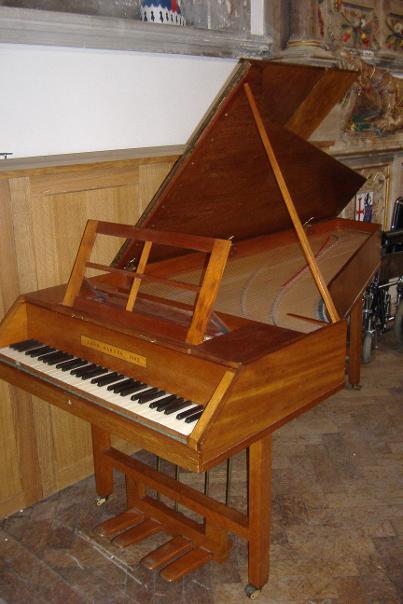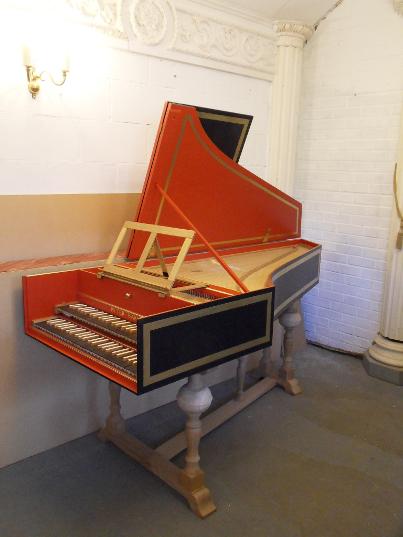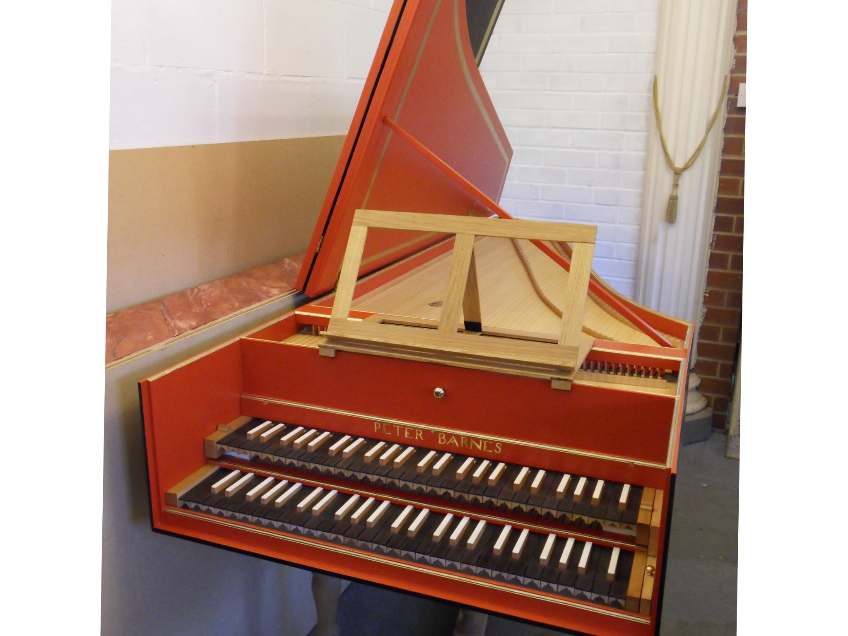Last updated on 22nd October 2024.
Welcome to my website.
As well as accepting work myself, you may like to see if there are other harpsichord makers and technicians that I recommend closer to where you live: uk-harpsichord-makers-and-technicians
If you would like a musical holiday why not go to London https://lifem.org/
or Malta? https://www.festivals.mt/whatson
- Leigh Flanders Flemish Harpsichord 1986.
- Italian Harpsichord by Colin Booth 2012.
- Kirchmann copy in revival case by John Barnes 1962.
- Italian Harpsichord after Gregori now being made. ETA December 2024.
- Flemish Harpsichord C-c3 compass.
- Dolmetsch Spinet.
- Small Virginal made by Christopher Barlow.
FF-f3 compass with 2 x 8' stops and buff stop. Can be tuned to a=415 or 440.
Turned oak stand and veneered case with printed papers in the keywell and round the soundboard. There is a gold lettered text in the lid which reads: And Music Shall Untune The Sky.
The case measures 212cm long, 92cm wide and 28cm high and it sits on a stand which is 64cm high.
This harpsichord is in good playing condition and is complete with tuning key and spare plectra.
Available now for £1,750. Sold.
ZOOM0155.MP3
ZOOM0156.MP3
2 x 8' stops C-c3, four octave compass. Wooden jacks and registers, spruce soundboard and beech wrestplank. This harpsichord is currently in poor playing and decorative condition, but could be bought 'as seen' for renovation. Alternatively, it will be available once I have replaced strings and plectra, serviced, cleaned it and repainted the stand and lid stick.
Once playing, this will be an ideal small, light, continuo instrument.
'As seen' £1,300
Renovated, in full playing condition £3,450.
Walnut spinet measuring only 130cm long, by 78cm at the widest point from the spine to the treble end of the keyboard, by 20cm high. This spinet is on a stand which is 61cm high and can be dismantled into four parts for ease of packing and transport. This instrument will be excellent for accompanying small ensembles and has a 5 octave compass from FF-f3
This spinet is in partial playing condition with replacement bird quill plectra and can be bought as seen, with spare quills for £850. It will be available once renovated and in full playing condition for £1650.
2 x 8' stops with buff stop. C/E short octave to e3 (without eb3). Transposing keyboard giving 415/440 or 440/465 tunings. This compact and light harpsichord is strung in brass wire and has a cedarwood case, spruce soundboard, boxwood and ebony keyboard and pearwood jacks, registers, bridges and wrestplank.
The tone is large and full and the touch responsive and even. This instrument weighs 25kg and is 191cm long, 81cm wide and 24cm high.
This harpsichord is now sold and the new owner, Debra Wong, has sent me this recording of her playing:
ZOOM0134.MP3
ZOOM0135.MP3
ZOOM0136.MP3
ZOOM0137.MP3
ZOOM0138.MP3
ZOOM0139.MP3


Small Virginal for sale made by Christopher Barlow:
This unusual instrument by the distinguished builder Christopher Barlow was designed with portability in mind - in fact to be accommodated on the back seat of an ordinary car - and it has certainly achieved this. The bass strings are parallel to the keyboard but those for the upper half of the compass are obliquely arranged, thereby reducing the depth of the instrument; this layout has worked well.
Please note that there is a small open joint in the lid, which of course has no effect on the tone.
The compass is 4½ octaves, C - f3; this versatile and practical instrument has a transposing keyboard to play at A 392, 415, or 440 with no loss of notes; it also has a buff stop. It is in Cheltenham; the price is £1,400 o.n.o.
Please contact Simon Pickard simon.pickard.sp@gmail.com
Also The British Harpsichord Society: https://www.harpsichord.org.uk/for-sale/
And The Early Music Shop: https://earlymusicshop.com/collections/previously-owned-keyboards
Below are some of the instruments which I have sold recently:
This Double Manual Italian Harpsichord was made in 1994 with three 8' registers and brass scaling and was based on a historic instrument. The compass is AA-d3 and it now has 2 x 8' registers, one on each manual. The upper manual 8' also has a buff.
This harpsichord now has a new wrestplank and soundboard. It has been restrung with brass wire and has replacement plectra and is very stable and in full playing condition. The specification is 2 x 8' with buff, AA-d3, transposing with a full compass in a=392, 415, 440 and 468. The sound is full and satisfying!
The harpsichord measures 245cm long, 90cm wide, 28cm deep and has a protective travel cover.
Now sold.
ZOOM0133.MP3
BoothDouble1994.mp3
Delin Single Oct2020.mp3
Delin PB 2020 Back 8'.mp3
Delin PB 2020 Both 8's.mp3
Delin PB 2020 Buff stop.mp3
William Dow Italian.mp3
Morley Clavichordc1965.mp3
This Single Manual Italian Harpsichord was started at the London College of Furniture by Peter Stephens c.2000. It was at an early stage with the case made and sides prepared for fitting.
Peter Barnes has now finished the instrument and is is provided with 2 x 8' stops with buff stop and a transposing compass from C-d3 in both a=415 and 440 pitch.
The harpsichord has been strung in brass and bronze and produces a full and rich tone throughout the compass, ideal for solo repertoire and continuo playing.
The jacks are Pearwood and registers are Beech.
Now Sold. Orders taken. Price in the region of £9,000.
Italian Peter Stephens PB 2022.mp3
This harpsichord was completed in early 2020. It is based on the design of an anonymous 2-manual instrument in the Musical Instrument Museum, Leipzig, no. 74 in Herbert Henkel’s catalogue.
The original is considered to be German, and to have been made around 1700. It is unsigned, and has been internally altered at least once, but the basic design is very convincing, and attracted me to make a harpsichord particularly suited to the classic German repertoire of Bach, Handel, etc..
The compass of the original is GG – c3: a typical late 17th century compass. It was only necessary to extend the instrument a little in the treble to increase the keyboard to GG – e3, adding a transposer for use at a = 415 and a = 440. Stringing is in Rose iron and brass. Plectra are black Delrin, which has been shown to have exceptional longevity over my years as a harpsichord maker. The octave register is quilled in white Delrin, for ease of voicing.
The original’s Italianate filigree soundboard rose has been imitated, and additional decoration around the bridges and on the jack rail is in red and gold. The original’s rather odd Italian-style stand (probably from a different instrument) has been replaced by one in a German style. With removable legs and feet, it can be completely dismantled.
The touch is firm and reassuring, and the tone of this harpsichord is unusually bright and clear. I have found it well-suited to counterpoint, having unusual balance and clarity in all parts of the compass.
CBooth2020.mp3
Italian PB 2022 GG-e3.mp3


BB-d3. Transposing a=415/440. 2x8' with buff stop.
Case and lid made from French Poplar, Beech wrestplank, bridges, jacks and registers, Spruce soundboard, solid oak stand which can be reduced to three sections for transport. Case painted red and black with bronze powder bands. A compact double manual harpsichord which is ideal for concert hiring.
Size 212cm long, 82cm wide and 28cm high, on a stand which is 73cm high.
Now Sold. Orders taken.
Delin Double Goldberg Extracts 2020.mp3
English Harpsichord by Peter Barnes 2021.
English Harpsichord jan2022.mp3
This harpsichord was made by Peter Barnes in 2022. It is in the English tradition, based on the c.1713 bentside spinet by Keene and Brackley and the 1709 harpsichord by Thomas Barton. It has traditional wooden jacks, guides and keyboard, a detachable lid and a folding music desk. The case is solid timber and the inside of the case and the nameboard are cedar, with cross-banded capping.
The harpsichord is strung with Malcolm Rose Iron and brass wire, it has 2x8’ stops with Buff, and a walnut case and stand. The GG - f3 compass transposes A440 / 415 without loss of top or bottom notes.
The stand detaches from the harpsichord and can be easily packed flat. This harpsichord is 193cm long, 88cm wide and 21cm deep. An ideal instrument to use for hiring.
This harpsichord has been on long term hire and is now sold. A similar instrument may be available for about £8,000.
Good quality Keyboard instruments wanted.
I am happy to value your instrument for you and suggest how you could sell it if you would like helpful advice.
Further details on: selling-your-harpsichord.php
You can contact me by phone on 01373 831498 or (+44)7733619002, or by email peterbarnes850@btinternet.com or via this page: contact-us-and-instrument-transport-links.php